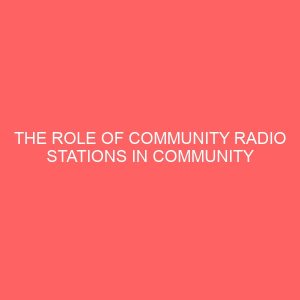Description
THIS RESEARCH IS ON BUSINESS COMBINATION AS A SURVIVAL STRATEGY IN A PERIOD OF ECONOMIC DEPRESSION.
ABSTRACT
Business combination is the fusion of separate business entities into a unified whole. It is a viable tools for combating economic depression. It sustains the viability, dynamism and value-enhancing capability of a company.
The company is able to attract the most talented executives and retain ‘ them. Coming together of two or more companies will result in synergy which is a situation where the combined firm is more valuable them the sum of the individual combined firms.
The research project is designed to study the role of business combination as a survival strategy in a period of economic depression.
From the analysis of the primary data gathered through the use of questionnaires, it was found that business combination is very important in the period of economic depression.
It was concluded, that more companies should also embrace business combination because of the numerous advantages ascribe to it.
CHAPTER ONE
1.1 INTRODUCTION
Business combination is the fusion of separate business entities into a unified whole. Business combination is one of the foremost strategy in shaping a firm’s strategic posture in the time of economic depression. Before we exploit in details business combination, it is important to look at the motives or aims of business in general.
According to Pearce, J.A. and Robinson, R.B. (2005), there are three Economic goals that guide the strategic direction of almost every viable business organizations. Whether or not they are explicitly stated, a company mission statement must reflect the three Economic goals which are profitability, survival and growth.
Profitability is the mainstay goal of a business organization. Profitability provides the justification and rationale for remaining in business. No matter how it is measured or defined, profit over the long term is the clearest indication of a firm’s ability to satisfy the principal claims and desires of employees and stockholders. This is why investors are only willing to invest in successful business organization such as the top players in Nigeria stock exchange market.
Business survival is another important goal of a business. Unless a firm is able to survive, it will be incapable of satisfying any of its stakeholders aims.
Lastly, the aim of business is to grow in size. A firm growth is tied to its ability to survive and be profitable. Growth means increase in size of an organization. Growth also means change, and proactive change is a necessity in a dynamic business environment.
The ability of a business enterprise to survive, grow and to make profit depends on its ability to operate effectively and efficiently in the business environment. The business environment is divided into two pails, the micro environment and macro environment. The micro-environment consists of various interest groups that make demands on the firm and with which the firm deals. The main elements of this environment are trade union, competitors, government, shareholders, distributors, consumers, suppliers and so on.
Macro environment are those element which the business does not have control over. They include demography, economic, political, socio-cultural factors, technology, competitor and others. The business enterprise must adapt to the environment by adopting measures that will enable them cope with such factors that may pose a threat or at the same time present opportunities for profitable business operations. In a bid to cope with these and exploit opportunities, business organization often formulate policies and implement strategies that will facilitate their survival and/or growth, one of such strategy is mergers and acquisitions.
Business combination is the fusion of separate business entities into a unified whole. Business combination strategies include merger, acquisition, absorption, amalgamation and takeover. These are instrument use in preventing the decline of companies and restoring them to a greater height.
Giwa (1987) stated that “merger and acquisition must be seen as an available means of saving companies from serious financial distress and providing such business with new management and better assets to new financial resources, such companies in distress are thus provided”. Merger according to Kazmi, A. (2005) “A merger is a combination of two or more organization in which one acquires the assets and liabilities of the other in exchange for shares or cash, or both organizations are dissolved and the assets and liabilities are combined and new stock is issued.”
The following are the salient reasons for business combination.
Enhances corporate performance
To ensure economics of scale
To lead to expansion in size of the business.
It reduces overhead cost of capital and enhances the earning per share.
It can lead to tax reduction
It can assist organization to expand their equity base through the reduction of debt/equity ratio.
To increase the profitability of the company
To enjoy a synergistic effect or advantage arising from sale operation investment, management and higher productivity.
Combination of strength in order to eliminate their individual weakness and exploit perceived opportunities
1.2OBJECTIVE OF THE STUDYThe general objectives of the study are investigating the visibility of business combination as a corporate survival strategy in a period of economic depression using Unilever Nigeria Plc. as a case study.
The specific objectives of the study business include the following:
To determine the extent to which business combination affect the firm’s profitability.
To find out the extent to which combined wealth of business organizations affect the market share of the firm’s product,
To obtain a broad overview of the effect of business combination on the turnover of an organization.
To ascertain the extent to which business combination improve the performance of an organization.
1.3RESEARCH QUESTIONBusiness is any lawful human activity which involves the production and distribution of goods or the rendering of services for the purpose of making profit. The objectives of any business are to maximize shareholders wealth, productivity, employee satisfaction, growth, public image offer reliable and efficient services to her customers.
Therefore, the motive is to evaluate the extent to which business combination play their role of achieving the above stated objectives has prompted the need to answer the following questions:
Does business combination have affect on a firm’s profitability?
Does the combined wealth improve the market share of the firm’s product?
What effect has business combination on turnover of an organization?
Does the business combination effect, improve the performance of the organization?
What is the overall effect of business combination in a firm’s?
1.4STATEMENT OF THE PROBLEMSThe present economic depression facing the Nigeria .nation started around 1982, when the austerity measures of the Shagari administration were launched, wherein many people began to witness economic turmoil, devaluation of Naira, persistent scarcity of foreign exchange, high inflation, recent high interest rates, couple with firm’s low capacity utilizations.
However the business sector has been employing one survival strategy or the other. This lead to the introduction of structural adjustment program in 1986, the stabilization security in 1992, privatization in the recent Obasanjo Government, the N25 billion recapitalization in 2005 and others, still yet the problems persist.
Business continues to face severe, further worsening of the unemployment situation and creating dis-investment. But then, If the economic must pull through the current depression and if life must go on, business must survive and be on-going, it is In connection with this that this research is looking into application of the business combination strategy with the aim of critically investigating into their suitability or otherwise as a survival strategy in a period of economic depression.
1.5 HYPOTHESIS FORMULATION In the course of this project work, below are hypothesis put forward to be tested as regard business combination under the case study.
HYPOTHESIS 1
Null Hypothesis (Ho): Business combination does not have affect on a firm’s profitability.
Alternative Hypothesis (Hi): Business combination have effect on a firm’s profitability:
HYPOTHESIS 2
Null Hypothesis (Ho): The combined wealth of the companies does not improve the market share of the firm’s product.
Alternative Hypothesis (Hi): The combined wealth of the companies improve the market share of the firm’s product.
HYPOTHESIS 3
Null Hypothesis (Ho): Business combination does not affect turnover of the organization.
Alternative Hypothesis (Hi): Business combination affect turnover of the organization.
HYPOTHESIS 4
Null Hypothesis (Ho): The effect of business combination does not improve the performance of an organization.
Alternative Hypothesis (Hi): The effect of business combination improves the performance of an organization.
1.6SIGNIFICANCE OF THE STUDYThe reason for this study is to determine strategies of surviving economic depression in ever dynamic business environment. The present economic scenario in Nigeria calls for pooling together of resources and more efficient and optimal use of revitalization, economies of scale, profitability, risk diversification, skill and management acquisition, technology acquisition and enhanced growth.
This research work will be useful to all companies in Nigeria, especially those in manufacturing and banking sectors which require large capital to be able to survive.
This research work is also very important to companies that do not have potential to survive in the present economic but have potential of merging with other companies.
Furthermore, the research will also serve as a guide to those who may want to research in the area of business combination.
It will serve as a guide to policy makers in relation to strategies of expanding and increasing the profitability of the organization.
Finally, it is expected that this research work will go beyond the accounting stage of research, do more than report opinions, judgments and views but rather will contribute significantly to existing information and make suggestion as to how to improve business combination strategy.
1.7SCOPE OF THE STUDY This research work does not encompass the entire subject matter of business combination in Nigeria business community but it only compasses mergers and acquisitions. It focused on the performance of one of the few Nigeria companies that acquired or merged with another between 1985 and 1988, the companies Level Nigeria Plc, a quoted company that merged with Lipton of Nigeria Ltd., an unlisted company in 1985.
1.8LIMITATION OF THE STUDY The following are the limitations:
Unwillingness of some of the respondents to complete the questionnaires or provide the needed information. Bureaucracy associated with Unilever Nigeria Plc.
1.9DEFINITION OF ITEMS To enhance a better understanding of this work, some important terms use in this research are defined below:
Absorption:- Absorption is a situation were a company takeover the same business of another company
Acquisition:- An acquisition occurs when one company acquire, sufficient shares in another company so as to give it control of that other company.
Business combination:- Ilaboye, OJ. (1005, 457) define Business combination as The fusion of separate business entities into a unified whole”.
Concentric:- Take place when there is a combination of two or more organizations related to each other either in terms of customer functions, customer groups, or the alternative technologies used,
Conglomerate:- The companies involved here are engaged in completely different kinds of business,
Horizontal:- where two companies involved in a take-over or merger produce the same kind of goods or render identical services,
Merger – GIWA (1989) “A merger is the combination or integration of existing companies”. Section 590 of the CAMA (1990) defined merger as “any amalgamation of the undertakings or any part of the undertakings or interest of two or more companies or the undertaking or part of the undertakings of one or more companies and one or more bodies corporate.
Synergy;- Ansoff and McDonnell (1990): “Synergy is the sharing of capabilities among units or components of merged firms which produces performance which is greater than the performance which can be obtained if the units operate independently of one another.
Take-over:- An offer to acquire shares of a company, whose shares are not closely held, addressed to the general body of shareholders with a view to obtaining at least sufficient shares to give the offer or voting control of the company.
Vertical:- Take place when there is a combination of two or more organizations, hot necessarily in the business, which create complimentarily either in the terms of supply of material (inputs) or marketing of goods and services (outputs).
REFERENCESGIWA, R.F. (1989) Merger and Acquisition: Moralities and Reality of Implementation, Journal of Nigeria Institute of management.
Ilaboyo J.O. (2005) Advanced Financial Accounting, Ibadan, Dalag Prints and Packaging Limited. Inegbenebor,
A.U. and Osazee, E.B. (1999) Introduction to Business Benin City, Malthouse Press Limited. Isenmila, P.A. and Eriki, O.P. (2000) Merger as a Corporate Performance Strategy, Journal of Social Sciences.
Kazmi, A (2005) Business Policy and Strategic Management Tata McGraw-Hill Publishing Company Limited, New Delhi, (India). Merriam – Webster’s Collegiate Dictionary, Tenth Ed.
Pearce II, J.A. and Robinson Son, R.B.JR. (2005) Strategic Management, Strategy Formulation and Implementation, A.I.T.B.S Publishers and Distributors (Regd), New Delhi, India, 3rd Ed.








Reviews
There are no reviews yet.